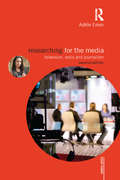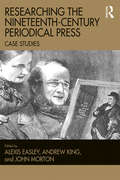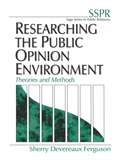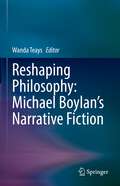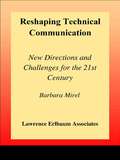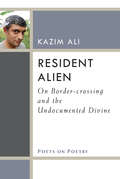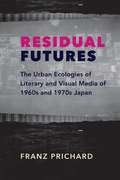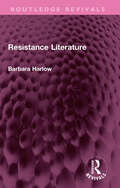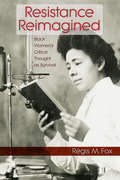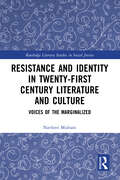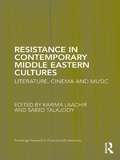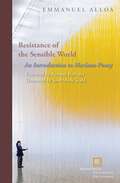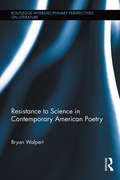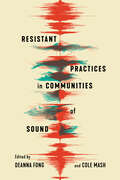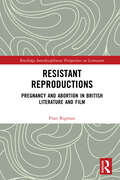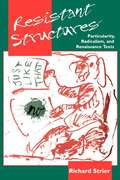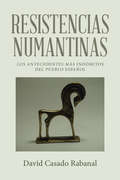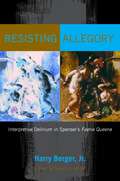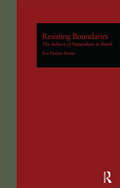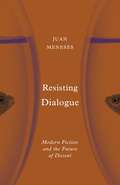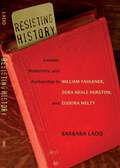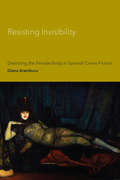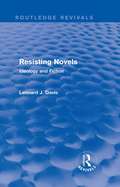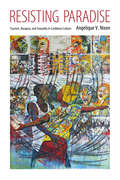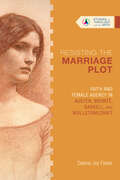- Table View
- List View
Researching for the Media: Television, Radio and Journalism (Media Skills)
by Adele EmmResearching for the Media: Television, Radio and Journalism is an essential guide to researching for the media industry. It explains the role of the researcher and journalist within radio, television and journalism exploring key areas of what to expect in the job. Researching for the Media: Television, Radio and Journalism offers advice and instruction on practical, ethical and legal issues which affect anyone working in these industries. Beginning with suggestions on how to think up ideas and how to devise treatments, through to general research methods and techniques and guidance on working on location at home and abroad, it uses real examples of good and bad practice from the industry. Written by an experienced researcher, writer and producer, Researching for the Media includes: Tips on finding contributors from contestants, experts and specialists through to audiences and celebrities How to find photographs, picture and film clips and the ethical and legal issues involved Advice on finding and using music and copyright issues How the media uses the internet and social media such as Twitter, Facebook, Instagram A discussion of risk assessment, codes of conduct, ethical behaviour and legal and safety issues A glossary of media terms, further reading and a list of helpful websites. Discover more at www.adeleemm.com
Researching the Nineteenth-Century Periodical Press: Case Studies
by John Morton Andrew King Alexis EasleyExtending the work of The Routledge Handbook to Nineteenth-Century British Periodicals and Newspapers, this volume provides a critical introduction and case studies that illustrate cutting-edge approaches to periodicals research, as well as an overview of recent developments in the field. The twelve chapters model diverse approaches and methodologies for research on nineteenth-century periodicals. Each case study is contextualized within one of the following broad areas of research: single periodicals, individual journalists, gender issues, periodical networks, genre, the relationship between periodicals, transnational/transatlantic connections, technologies of printing and illustration, links within a single periodical, topical subjects, science and periodicals, and imperialism and periodicals. Contributors incorporate first-person accounts of how they conducted their research and provide specific examples of how they gained access to primary sources, as well as the methods they used to analyze the materials. The 2018 winner of the Robert and Vineta Colby Scholarly Book Prize. The Committee describes the focus of the book on methodology and case studies as “fresh and original,” and “useful for both experienced scholars and those new to the field.” "Overall. Case Studies suggests new ways of reading canonical authors, new unerstandings of the interprentation of the personal and the public, and an admirable energy in engaging with the structures of national and transnational periodical discourses that are clearly implicated in maintaining soft power within societies" -- Brian Maidment, Liverpool John Moores University
Researching the Public Opinion Environment: Theories and Methods
by Sherry Devereaux FergusonResearching the Public Opinion Environment: Theories and Methods informs the reader on the rationale, purposes, theories, and methodologies involved in researching the public. The book is divided into four parts. Part One looks at the theories and systems relevant to opinion research. Part Two addresses the topics of monitoring and analyzing the media. Part Three describes the basics of survey research, focus groups, Delphi techniques, stakeholder assemblies and Q methodology. Part Four analyzes the impact of the media.
Reshaping Philosophy: Michael Boylan’s Narrative Fiction
by Wanda TeaysThis volume offers original essays exploring what ‘fictive narrative philosophy’ might mean in the research and teaching of philosophy. The first part of the book presents theoretical essays that examine Boylan’s recent books: Teaching Ethics with Three Philosophical Novels and Fictive Narrative Philosophy: How Literature can Act as Philosophy. The second and third part offer essays on how Boylan executes his theory in the practice within his novels from his two series De Anima and Archē. The book clearly shows the unique aspects of the fictive narrative philosophy approach. First, it makes story-telling accessible to wide audiences. Second, story-telling techniques invoke devices that can set out complicated existential problems to the reader that offer an additional approach to thorny problems through the presentation of lived experience. Third, the discussion of these devices is a way to explore philosophical problems in a way that many can profit from. The book concludes with an essay in which Boylan responds to the critical challenges set out in Part One and the practical criticism set out in Parts Two and Three. Boylan addresses the key claims made by his objectors and defends his position. He engages with the authors in the way his theory is matched against his actual novels. This is useful reading for both philosophers and professors of literature teaching introductory as well as upper-level courses in the fields of philosophy, literature and criticism.
Reshaping Technical Communication: New Directions and Challenges for the 21st Century
by Barbara Mirel Rachel SpilkaThis anthology brings together voices from industry and academia in a call for elevating the status, identity, value, and influence of technical communicators. Editors Barbara Mirel and Rachel Spilka assert that technical communicators must depart from their traditional roles, moving instead in a more influential and expansive direction. To help readers explore the possibilities, contributions from innovative thinkers and leaders in technical communication propose ways to redefine the field's identity and purposes and to expand the parameters of its work. The chapters included here all point toward new directions for greater growth and influence of the field. Contributors depart from traditional ideas and solutions and discuss new and in some cases radical points, provoking further thought and discussion. Its exploration of fresh territory uncovers new research topics and directions, and provides an examination of both internal, industry-academia relationships and external relationships between technical communicators and other professionals. In its entirety, this collection represents an inclusive vision for the future, targeting such wide-ranging issues as creating effective professional organizations, disseminating research to diverse audiences, transitioning to more influential job roles, exerting leadership in usability, and creating hybrid identities and collaborative programs between industry and academic to support them. The diverse voices from industry and academia will inspire readers to think differently about the discipline's identity and direction, and to build on the ideas they find herein to effect change within their own spheres. As required reading for academics and professionals in technical communication, this collection is a critical step in reshaping and reinvigorating the technical communication field to ensure its survival and growth in the 21st century.
Resident Alien: On Border-crossing And The Undocumented Divine
by Mohammed Kazim AliKazim Ali uses a range of subjects--the politics of checkpoints at international borders; difficulties in translation; collaborations between poets and choreographers; and connections between poetry and landscape, or between biotechnology and the human body--to situate the individual human body into a larger global context, with all of its political and social implications. He finds in the quality of ecstatic utterance his passport to regions where reason and logic fail and the only knowledge is instinctual, in physical existence and breath. This collection includes Ali's essays on topics such as Anne Carson's translations of Euripides; the poetry and politics of Mahmoud Darwish; Josey Foo's poetry/dance collaborations with choreographer Leah Stein; Olga Broumas' collaboration with T. Begley; Jorie Graham's complication of Kenneth Goldsmith's theories; the postmodern spirituality of the 14th century Kashmiri mystic poet Lalla; translations of Homer, Mandelstam, Sappho, and Hafez; as well as the poet Reetika Vazirani's practice of yoga. "Ali has a vibrant and generous personality that lets one hear the inner music that makes us remember what it is to be human. " --Painted Bride Quarterly
Residual Futures: The Urban Ecologies of Literary and Visual Media of 1960s and 1970s Japan (Studies of the Weatherhead East Asian Institute, Columbia University)
by Franz PrichardIn the postwar years, an eruption of urbanization took place across Japan, from its historical central cities to the outer reaches of the archipelago. During the 1960s and 1970s, Japanese literary and visual media took a deep interest in cities and their problems, and what this rapid change meant for the country. In Residual Futures, Franz Prichard offers a pathbreaking analysis of the works wrought from this intensive urbanization, mapping the ways in which Japanese filmmakers, writers, photographers, and other artists came to grips with the entwined ecologies of a drastic transformation.Residual Futures examines crucial works of documentary film, fiction, and photography that interrogated Japan’s urbanization and integration into the U.S.-dominated geopolitical system. Prichard discusses documentary filmmaker Tsuchimoto Noriaki’s portrait of the urban “traffic war” and the remaking of Tokyo for the 1964 Olympics, novelist Abe Kōbō’s depictions of infrastructure and urban sociality, and the radical notions of landscape that emerge from the critical and photographic work of Nakahira Takuma. His careful readings reveal the shifting relationships among urban materialities and subjectivities and the ecological, political, and aesthetic vocabularies of urban change. A novel cultural history of critical urban discourse in Japan, Residual Futures brings an interdisciplinary approach to Japanese literary and visual media studies. It provides a vital new perspective on the infrastructural aesthetics and entangled urban and media conditions of the global Cold War.
Resistance Literature (Routledge Revivals)
by Barbara HarlowAs one of the foundational texts in the field of postcolonial writing, Barbara Harlow’s Resistance Literature introduced new ground in Western literary studies. Originally published in 1987 and now reissued with a new Preface by Mia Carter, this powerfully argued and controversial critique develops an approach to literature which is essentially political. Resistance Literature introduces the reader to the role of literature in the liberation movements of the developing world during the 20th Century. It considers a body of writing largely ignored in the west. Although the book is organized according to generic topics – poetry, narrative, prison memoirs – thematic topics, and the specific historical conditions that influence the cultural and political strategies of various resistance struggles, including those of Palestine, Nicaragua and South Africa, are brought to the fore. Among the questions raised are the role of women in the developing world; communication in circumstances of extreme atomization; literature versus propaganda; censorship; and the problem of adopting literary forms identified with the oppressor culture.
Resistance Reimagined: Black Women's Critical Thought as Survival
by Regis M. FoxResistance Reimagined highlights unconventional modes of black women's activism within a society that has spoken so much of freedom but has granted it so selectively. Looking closely at nineteenth- and twentieth-century writings by African American women that reimagine antebellum America, Regis Fox introduces types of black activism that differ from common associations with militancy and maleness. In doing so, she confronts expectations about what African American literature can and should be. Fox analyzes Harriet Wilson's Our Nig, Elizabeth Keckly's Behind the Scenes, Anna Julia Cooper's A Voice From the South, and Sherley Anne Williams's Dessa Rose. The thinkers highlighted by Fox have been dismissed as elitist, accommodationist, or complicit—yet Fox reveals that in reality, these women use their writing to protest antiblack violence, reject superficial reform, call for major sociopolitical change, and challenge the false promises of American democracy.
Resistance and Identity in Twenty-First Century Literature and Culture: Voices of the Marginalized (Routledge Literary Studies in Social Justice)
by Navleen MultaniResistance and Identity in Twenty-First Century Literature and Culture: Voices of the Marginalized is a compendium of reflections on literary texts, politics of literature and culture. The book proffers ruminations on the pivotal role of constructive and positive resistance to reconstruct identities for meaningful human existence. The disciplinary power and dominance coerce the natural body to resist and yearn for freedom. One can establish unique identity by refusing to conform to pressures of society that deform the natural body. Dominant forces and oppressive structures evoke resistance that can range from 'polite demurral' to 'refusal'. Resistance comes from the 'will' that refuses to be controlled and governed. The 'refusal' of the ordinary illuminates ordinary lives/ bodies. Language and literary texts contain essential truths of such human existence. Words and imaginary worlds in literary works reveal truth and suggest possibilities for reconfiguring the order.
Resistance in Contemporary Middle Eastern Cultures: Literature, Cinema and Music (Routledge Research in Postcolonial Literatures)
by Karima Laachir Saeed TalajooyThis study highlights the connections between power, cultural products, resistance, and the artistic strategies through which that resistance is voiced in the Middle East. Exploring cultural displays of dissent in the form of literary works, films, and music, the collection uses the concept of 'cultural resistance' to describe the way culture and cultural creations are used to resist or even change the dominant political, social, economic, and cultural discourses and structures either consciously or unconsciously. The contributors do not claim that these cultural products constitute organized resistance movements, but rather that they reflect instances of defiance that stem from their peculiar contexts. If culture can be used to consolidate and perpetuate power relations in societies, it can also be used as the site of resistance to oppression in its various forms: gender, class, ethnicity, and sexuality, subverting existing dominant social and political hegemonies in the Middle East.
Resistance of the Sensible World: An Introduction to Merleau-Ponty (Perspectives in Continental Philosophy)
by Emmanuel AlloaIn this book, Emmanuel Alloa offers a handrail for venturing into the complexities of the work of the French philosopher Maurice Merleau-Ponty (1908–61). Through a comprehensive analysis of the three main phases of Merleau-Ponty’s thinking and a thorough knowledge of his many unpublished manuscripts, the author traces how Merleau-Ponty’s philosophy evolved and exposes the remarkable coherence that structures it from within. Alloa teases out the continuity of a motive that traverses the entire oeuvre as a common thread. Merleau-Ponty struggled incessantly against any kind of ideology of transparency, whether of the world, of the self, of knowledge, or of the self’s relation to others.Already translated into several languages, Alloa’s innovative reading of this crucially important thinker shows why the issues Merleau-Ponty raised are, more than ever, those of our time.
Resistance to Science in Contemporary American Poetry (Routledge Interdisciplinary Perspectives on Literature)
by Bryan WalpertThis book examines types of resistance in contemporary poetry to the authority of scientific knowledge, tracing the source of these resistances to both their literary precedents and the scientific zeitgeists that helped to produce them. Walpert argues that contemporary poetry offers a palimpsest of resistance, using as case studies the poets Alison Hawthorne Deming, Pattiann Rogers, Albert Goldbarth, and Joan Retallack to trace the recapitulation of romantic arguments (inherited from Keats, Shelly, and Coleridge, which in turn were produced in part in response to Newtonian physics), modernist arguments (inherited from Eliot and Pound, arguments influenced in part by relativity and quantum theory), and postmodernist arguments (arguments informed by post-structuralist theory, e.g. Barthes, Derrida, Foucault, with affinities to arguments for the limitations of science in the philosophy, sociology, and rhetoric of science). Some of these poems reveal the discursive ideologies of scientific language—reveal, in other words, the performativity of scientific language. In doing so, these poems themselves can also be read as performative acts and, therefore, as forms of intervention rather than representation. Reading Retallack alongside science studies scholar Karen Barad, the book concludes by proposing that viewing knowledge as a form of intervention, rather than representation, offers a bridge between contemporary poetry and science.
Resistant Practices in Communities of Sound
by Deanna Fong and Cole MashPrint – and by extension, visuality – has historically dominated the literary, artistic, and academic spheres in Canada; however, scholars and artists have become increasingly attuned to the creative and scholarly opportunities offered by paying attention to sound.Resistant Practices in Communities of Sound turns to a particular opportunity, interrogating the ways that sonic practices act as forms of aesthetic and political dissent. Chapters explore, on the one hand, critical methods of engaging with sound – particularly bodies of literary and artistic work in their specific materiality as read, recited, performed, mediated, archived, and remixed objects; on the other hand, they also engage with creative practices that mobilize sound as a political aesthetic, taking on questions of identity, racialization, ability, mobility, and surveillance. Divided into nine pairings that bring together works originating in oral/aural forms with works originating in writing, the book explores the creative and critical output of leading sonic practitioners. It showcases diverse approaches to the equally complex formations of sound, resistance, and community, bridging the too-often separate worlds of the practical and the academic in generative, resonant dialogue.Combining the oral and the written, the creative and the critical, and the mediated and the live, Resistant Practices in Communities of Sound asks us to attune ourselves as listeners as well as readers.
Resistant Reproductions: Pregnancy and Abortion in British Literature and Film (Routledge Interdisciplinary Perspectives on Literature)
by Fran BigmanResistant Reproductions asks why narratives of pregnancy and abortion emerged in the early twentieth century and what kinds of stories these narratives conveyed. Is it only once pregnancy becomes plannable that it becomes a story worth telling? Abortion is often considered resistant and feminist, while pregnancy is considered domestic and conventional. How can readings of literary narratives challenge this reductive binary?Resistant Reproductions, the first book-length study of both pregnancy and abortion in British culture, addresses these questions by examining pregnancy narratives, including abortion narratives, in British fiction and film from 1907 to 1967. Fiction became a way for writers to explore what new possibilities of reproductive control would mean for the individual, yet there was also much anxiety about who would have control: individuals or the state. While exploring intimate personal experiences of pregnancy and abortion, Resistant Reproductions also asks how literary narratives used reproductive plots to address political issues of gender, class, and eugenics.
Resistant Structures: Particularity, Radicalism, and Renaissance Texts (The New Historicism: Studies in Cultural Poetics #34)
by Richard StrierTaking Wittgenstein's "Don't think, but look" as his motto, Richard Strier argues against the application of a priori schemes to Renaissance (and all) texts. He argues for the possibility and desirability of rigorously attentive but "pre-theoretical" reading. His approach privileges particularity and attempts to respect the "resistant structures" of texts. He opposes theories, critical and historical, that dictate in advance what texts must—or cannot—say or do.The first part of the book, "Against Schemes," demonstrates, in discussions of Rosemond Tuve, Stephen Greenblatt, and Stanley Fish among others, how both historicist and purely theoretical approaches can equally produce distortion of particulars. The second part, "Against Received Ideas," shows how a variety of texts (by Shakespeare, Donne, Herbert, and others) have been seen through the lenses of fixed, mainly conservative ideas in ways that have obscured their actual, surprising, and sometimes surprisingly radical content.
Resistencias numantinas: Los antecedentes más indómitos del pueblo español
by David Casado RabanalAl abordar la historia española casi siempre es preciso despojarla de las muchas ensoñaciones, mitos y leyendas que la revisten o engalanan, incluyendo el maleficio de las perlas negras que aún brillan con luz propia. Resistencias numantinas trae al primer plano de la actualidad nuestro más remoto pasado, para exponer con claridad y rigurosidad las contiendas de algunos de los pueblos que habitaron la península Ibérica, mucho antes de resultar mitificadas por el nacionalismo español. Todos y cada uno de los relatos abordados en este libro, han contribuido poderosamente a elaborar la fama y la leyenda de los grandes atributos guerreros del pueblo español, alimentando sus mitos más heroicos. Estos giran en torno a la vieja devoción por el honor, el sacrificio de la propia vida, el sentido del deber, o la resistencia a ultranza frente al enemigo. Otra cosa es saber cuánto hay de cierto en esas historias, que han proyectado sobre los españoles el mito de ser un pueblo indómito e ingobernable, tan orgulloso como cainita, en sus más profundas esencias. Heredadas, sin duda, de la épica lucha indígena contra Roma, y más adelante, de la larga e identitaria reconquista cristiana del perdido reino visigodo, en poder de los musulmanes durante casi ocho siglos,que reforjaría nuevamente todos los atavismos ibéricos. Con estos mimbres, el autor realiza un ponderado y documentado análisis, sobre los usos y abusos de los nacionalismos hispanos respecto al pasado. Sin dejar de lado en su exposición una lúcida reflexión sobre el ejercicio del poder, y las funestas consecuencias de llevar a cabo las peores ambiciones humanas, encarnadas en muchos de los hombres y mujeres que dan vida y protagonismo a estos apasionantes relatos."
Resisting Allegory: Interpretive Delirium in Spenser's Faerie Queene
by Harry BergerSpenser is a delirious poet. He can’t plough straight. What he builds is shiftier, twistier, than anything dreamed up or put down by M. C. Escher. So begins Resisting Allegory, in which the leading Spenser critic of our time sums up a lifelong commitment to the theory and practice of textual interpretation. Spenser’s great poem provides the occasion for a searching and comprehensive interdisciplinary exploration of reading practices¾those the author advocates as well as those he adapts or criticizes in entertaining a wide range of critical arguments with his celebrated combination of intellectual generosity and rigorous questioning.Berger is interested in how details of the poem's language—phrases, images, figures on which we haven’t put enough interpretive pressure—disconcert traditional interpretations and big discourses that the poem has often been thought to serve. Central to this volume is an attention to the deployment of gender in conjunction with the Berger’s notion of narrative complicity.Resisting Allegory offers a model of theoretically sophisticated criticism that never wavers in its close attention to the text. Berger offers a sustained and brilliantly articulated resistance not only to allegory, as the title indicates, but also to prevalent modes of cultural and historical criticism. As in all of Berger’s books, a lucid reflection on questions of method—based on a profound and richly theoretically informed understanding of the workings of language and of the historical situations of the people involved in it—are interwoven with an interpretive practice that serves as an exemplary pedagogical model. Berger attends to historical and political context while deeply respecting the ways in which text can never be reduced to context. This distinctive and original book makes clear the scope and coherence of the critical vision elaborated Berger has elaborated in a lifetime of seminal and still-challenging critical arguments.
Resisting Boundaries: The Subject of Naturalism in Brazil
by Eva P. BuenoThis book consists of the study of five Brazilian novels produced in the last decades of the nineteenth century: O mulato (1881), O cortigo (1890), both by Aluisio Azevedo, A came (1888), by Julio Ribeiro, Bom-Crioulo (1895), by Adolfo Caminha, and Dona Guidinha do Pogo (1897) by Manoel de Oliveira Paiva. These novels, traditionally considered naturalist, portray tensions caused by the realignment, or, better still, the sudden visibility of people such as strong women, blacks, mulattoes, and homosexuals in Brazilian fiction.
Resisting Dialogue: Modern Fiction and the Future of Dissent
by Juan MenesesA bold new critique of dialogue as a method of eliminating dissent Is dialogue always the productive political and communicative tool it is widely conceived to be? Resisting Dialogue reassesses our assumptions about dialogue and, in so doing, about what a politically healthy society should look like. Juan Meneses argues that, far from an unalloyed good, dialogue often serves as a subtle tool of domination, perpetuating the underlying inequalities it is intended to address.Meneses investigates how &“illusory dialogue&” (a particular dialogic encounter designed to secure consensus) is employed as an instrument that forestalls—instead of fostering—articulations of dissent that lead to political change. He does so through close readings of novels from the English-speaking world written in the past hundred years—from E. M. Forster&’s A Passage to India and Jeanette Winterson&’s The Passion to Indra Sinha&’s Animal&’s People and more. Resisting Dialogue demonstrates how these novels are rhetorical exercises with real political clout capable of restoring the radical potential of dialogue in today&’s globalized world. Expanding the boundaries of postpolitical theory, Meneses reveals how these works offer ways to practice disagreement against this regulatory use of dialogue and expose the pitfalls of certain other dialogic interventions in relation to some of the most prominent questions of modern history: cosmopolitanism at the end of empire, the dangers of rewriting the historical record, the affective dimension of neoliberalism, the racial and nationalist underpinnings of the &“war on terror,&” and the visibility of environmental violence in the Anthropocene. Ultimately, Resisting Dialogue is a complex, provocative critique that, melding political and literary theory, reveals how fiction can help confront the deployment of dialogue to preempt the emergence of dissent and, thus, revitalize the practice of emancipatory politics.
Resisting History: Gender, Modernity, and Authorship in William Faulkner, Zora Neale Hurston, and Eudora Welty (Southern Literary Studies)
by Barbara LaddIn a major reinterpretation, Resisting History reveals that women, as subjects of writing and as writing subjects themselves, played a far more important role in shaping the landscape of modernism than has been previously acknowledged. Here Barbara Ladd offers powerful new readings of three southern writers who reimagined authorship between World War I and the mid-1950s.Ladd argues that the idea of a "new woman" -- released from some of the traditional constraints of family and community, more mobile, and participating in new contractual forms of relationality -- precipitated a highly productive authorial crisis of gender in William Faulkner. As "new women" themselves, Zora Neale Hurston and Eudora Welty explored the territory of the authorial sublime and claimed, for themselves and other women, new forms of cultural agency. Together, these writers expose a territory of female suffering and aspiration that has been largely ignored in literary histories.In opposition to the belief that women's lives, and dreams, are bound up in ideas of community and pre-contractual forms of relationality, Ladd demonstrates that all three writers -- Faulkner in As I Lay Dying, Welty in selected short stories and in The Golden Apples, and Hurston in Tell My Horse -- place women in territories where community is threatened or nonexistent and new opportunities for self-definition can be seized. And in A Fable, Faulkner undertakes a related project in his exploration of gender and history in an era of world war, focusing on men, mourning, and resistance and on the insurgences of the "masses" -- the feminized "others" of history -- in order to rethink authorship and resistance for a totalitarian age.Filled with insights and written with obvious passion for the subject, Resisting History challenges received ideas about history as a coherent narrative and about the development of U.S. modernism and points the way to new histories of literary and cultural modernisms in which the work of women shares center stage with the work of men.
Resisting Invisibility: Detecting the Female Body in Spanish Crime Fiction (Toronto Iberic)
by Diana AramburuEngaging with pre-feminist and male-authored crime literature, Resisting Invisibility offers a comparative reading of women’s bodies as represented in Spanish crime literature from the mid-nineteenth century to the present. Utilizing the twin concepts of visibility and invisibility, the book establishes a genealogy of differing viewpoints regarding women’s positions in these narratives, before and after the birth of the modern Spanish female detective. This examination of the politics of female visibility expands our understanding of the aesthetic regimes that have governed the female body from the early phases of the genre’s evolution. While most scholars understand the feminization of the crime genre as a response to second-wave feminism, Resisting Invisibility demonstrates that even in the earliest representations of delinquent women, the politics surrounding the female body are problematized and are more complex than previously conceptualized. Drawing on gender and queer studies, Resisting Invisibility investigates the gendering of crime fiction, forcing us to reconsider the literary history of female visibility and prompting us to establish an alternative genealogy for Spanish crime literature.
Resisting Novels: Ideology and Fiction (Routledge Revivals)
by Lennard J. Davis"By making friends with signs", Lennard Davis argues, "we are weakening the bond that anchors us to the social world, the world of action, and binding ourselves to the ideological." For the reader, this power of the novel needs to be resisted. But there is a double resistance at work: the novel is also a defensive structure positioning us against alienation and loneliness: the dehumanising symptoms of modern life. While discussions surrounding ideology in novels traditionally concentrate on thematics, in this study – first published in 1987 - Davis approaches the subject through such structural features as location, character, dialogue and plot. Drawing on a wide range of novels from the seventeenth century to the present day, and on psychoanalysis as well as philosophy, Resisting Novels explores how fiction works subliminally to resist change and to detach the reader from the world of lived experience. This controversial critique will engage students and academics with a particular interest in literary theory.
Resisting Paradise: Tourism, Diaspora, and Sexuality in Caribbean Culture (Caribbean Studies Series)
by Angelique V. NixonWinner of the Caribbean Studies Association's 2016 Barbara T. Christian Award for Best Book in the Humanities Tourists flock to the Caribbean for its beaches and spread more than just blankets and dollars. Indeed, tourism has overly affected the culture there. Resisting Paradise explores the import of both tourism and diaspora in shaping Caribbean identity. It examines Caribbean writers and others who confront the region's overdependence on the tourist industry and the many ways that tourism continues the legacy of colonialism. Angelique V. Nixon interrogates the relationship between culture and sex within the production of “paradise” and investigates the ways in which Caribbean writers, artists, and activists respond to and powerfully resist this production. Forms of resistance include critiquing exploitation, challenging dominant historical narratives, exposing tourism's influence on cultural and sexual identity in the Caribbean and its diaspora, and offering alternative models of tourism and travel. Resisting Paradise places emphasis on the Caribbean people and its diasporic subjects as travelers and as cultural workers contributing to alternate and defiant understandings of tourism in the region. Through a unique multidisciplinary approach to comparative literary analysis, interviews, and participant observation, Nixon analyzes the ways Caribbean cultural producers are taking control of representation. While focused mainly on the Anglophone Caribbean, the study covers a range of territories including Antigua, the Bahamas, Grenada, Haiti, Jamaica, as well as Trinidad and Tobago, to deliver a potent critique.
Resisting the Marriage Plot: Faith and Female Agency in Austen, Brontë, Gaskell, and Wollstonecraft (Studies in Theology and the Arts Series)
by Dalene Joy Fisher"I cannot suppose any situation more distressing than for a woman of sensibility with an improving mind to be bound to such a man as I have described." Mary Wollstonecraft's response to one of her early critics points to the fact that fiction has long been employed by authors to cast a vision for social change. Less acknowledged, however, has been the role of the Christian faith in such works. In this latest volume in IVP Academic's Studies in Theology and the Arts series, literary scholar Dalene Joy Fisher explores the work of four beloved female novelists: Jane Austen, Anne Brontë, Elizabeth Gaskell, and Mary Wollstonecraft. Each of these authors, she argues, appealed to the Christian faith through their heroines to challenge cultural expectations regarding women, especially in terms of marriage. Although Christianity has all too often been used to oppress women, Fisher demonstrates that in the hands of these novelists and through the actions of their characters, it could also be a transformative force to liberate women.
